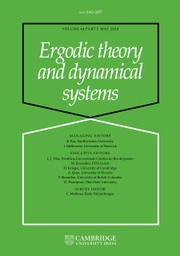Article contents
The  $\unicode[STIX]{x1D6FD}$-transformation with a hole at 0
$\unicode[STIX]{x1D6FD}$-transformation with a hole at 0
Published online by Cambridge University Press: 25 March 2019
Abstract
For  $\unicode[STIX]{x1D6FD}\in (1,2]$ the
$\unicode[STIX]{x1D6FD}\in (1,2]$ the  $\unicode[STIX]{x1D6FD}$-transformation
$\unicode[STIX]{x1D6FD}$-transformation  $T_{\unicode[STIX]{x1D6FD}}:[0,1)\rightarrow [0,1)$ is defined by
$T_{\unicode[STIX]{x1D6FD}}:[0,1)\rightarrow [0,1)$ is defined by  $T_{\unicode[STIX]{x1D6FD}}(x)=\unicode[STIX]{x1D6FD}x\hspace{0.6em}({\rm mod}\hspace{0.2em}1)$. For
$T_{\unicode[STIX]{x1D6FD}}(x)=\unicode[STIX]{x1D6FD}x\hspace{0.6em}({\rm mod}\hspace{0.2em}1)$. For  $t\in [0,1)$ let
$t\in [0,1)$ let  $K_{\unicode[STIX]{x1D6FD}}(t)$ be the survivor set of
$K_{\unicode[STIX]{x1D6FD}}(t)$ be the survivor set of  $T_{\unicode[STIX]{x1D6FD}}$ with hole
$T_{\unicode[STIX]{x1D6FD}}$ with hole  $(0,t)$ given by
$(0,t)$ given by  $$\begin{eqnarray}K_{\unicode[STIX]{x1D6FD}}(t):=\{x\in [0,1):T_{\unicode[STIX]{x1D6FD}}^{n}(x)\not \in (0,t)\text{ for all }n\geq 0\}.\end{eqnarray}$$
$$\begin{eqnarray}K_{\unicode[STIX]{x1D6FD}}(t):=\{x\in [0,1):T_{\unicode[STIX]{x1D6FD}}^{n}(x)\not \in (0,t)\text{ for all }n\geq 0\}.\end{eqnarray}$$ $E_{\unicode[STIX]{x1D6FD}}$ of all parameters
$E_{\unicode[STIX]{x1D6FD}}$ of all parameters  $t\in [0,1)$ for which the set-valued function
$t\in [0,1)$ for which the set-valued function  $t\mapsto K_{\unicode[STIX]{x1D6FD}}(t)$ is not locally constant. We show that
$t\mapsto K_{\unicode[STIX]{x1D6FD}}(t)$ is not locally constant. We show that  $E_{\unicode[STIX]{x1D6FD}}$ is a Lebesgue null set of full Hausdorff dimension for all
$E_{\unicode[STIX]{x1D6FD}}$ is a Lebesgue null set of full Hausdorff dimension for all  $\unicode[STIX]{x1D6FD}\in (1,2)$. We prove that for Lebesgue almost every
$\unicode[STIX]{x1D6FD}\in (1,2)$. We prove that for Lebesgue almost every  $\unicode[STIX]{x1D6FD}\in (1,2)$ the bifurcation set
$\unicode[STIX]{x1D6FD}\in (1,2)$ the bifurcation set  $E_{\unicode[STIX]{x1D6FD}}$ contains infinitely many isolated points and infinitely many accumulation points arbitrarily close to zero. On the other hand, we show that the set of
$E_{\unicode[STIX]{x1D6FD}}$ contains infinitely many isolated points and infinitely many accumulation points arbitrarily close to zero. On the other hand, we show that the set of  $\unicode[STIX]{x1D6FD}\in (1,2)$ for which
$\unicode[STIX]{x1D6FD}\in (1,2)$ for which  $E_{\unicode[STIX]{x1D6FD}}$ contains no isolated points has zero Hausdorff dimension. These results contrast with the situation for
$E_{\unicode[STIX]{x1D6FD}}$ contains no isolated points has zero Hausdorff dimension. These results contrast with the situation for  $E_{2}$, the bifurcation set of the doubling map. Finally, we give for each
$E_{2}$, the bifurcation set of the doubling map. Finally, we give for each  $\unicode[STIX]{x1D6FD}\in (1,2)$ a lower and an upper bound for the value
$\unicode[STIX]{x1D6FD}\in (1,2)$ a lower and an upper bound for the value  $\unicode[STIX]{x1D70F}_{\unicode[STIX]{x1D6FD}}$ such that the Hausdorff dimension of
$\unicode[STIX]{x1D70F}_{\unicode[STIX]{x1D6FD}}$ such that the Hausdorff dimension of  $K_{\unicode[STIX]{x1D6FD}}(t)$ is positive if and only if
$K_{\unicode[STIX]{x1D6FD}}(t)$ is positive if and only if  $t<\unicode[STIX]{x1D70F}_{\unicode[STIX]{x1D6FD}}$. We show that
$t<\unicode[STIX]{x1D70F}_{\unicode[STIX]{x1D6FD}}$. We show that  $\unicode[STIX]{x1D70F}_{\unicode[STIX]{x1D6FD}}\leq 1-(1/\unicode[STIX]{x1D6FD})$ for all
$\unicode[STIX]{x1D70F}_{\unicode[STIX]{x1D6FD}}\leq 1-(1/\unicode[STIX]{x1D6FD})$ for all  $\unicode[STIX]{x1D6FD}\in (1,2)$.
$\unicode[STIX]{x1D6FD}\in (1,2)$.
MSC classification
- Type
- Original Article
- Information
- Creative Commons
- This is an Open Access article, distributed under the terms of the Creative Commons Attribution licence (http://creativecommons.org/licenses/by/4.0/), which permits unrestricted re-use, distribution, and reproduction in any medium, provided the original work is properly cited.
- Copyright
- © The Author(s) 2019
References
- 13
- Cited by



